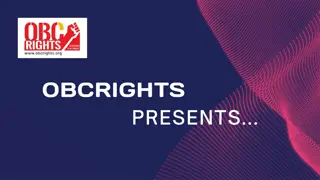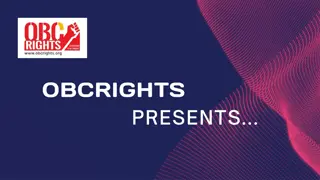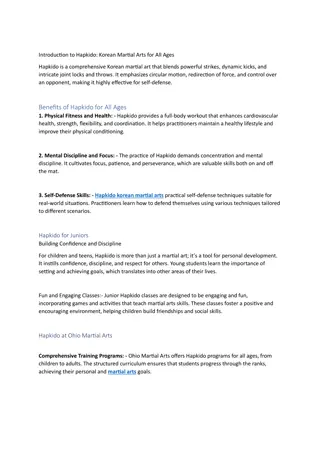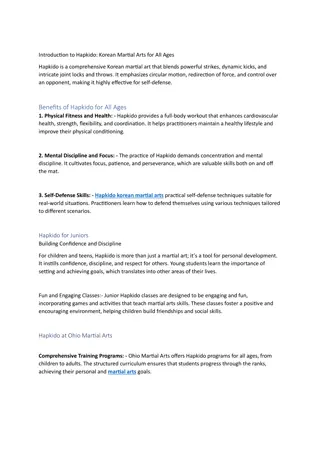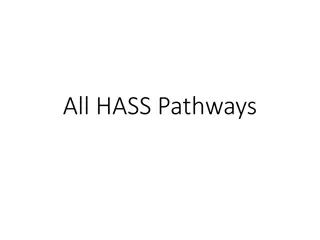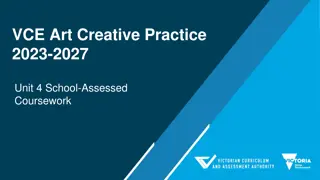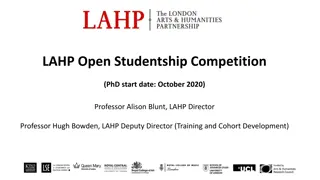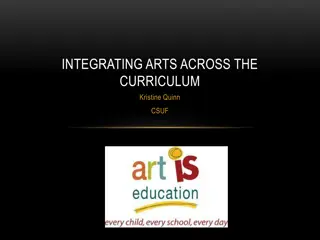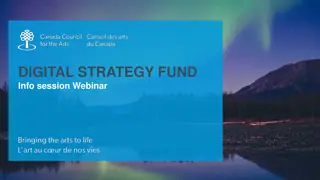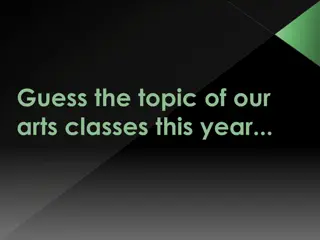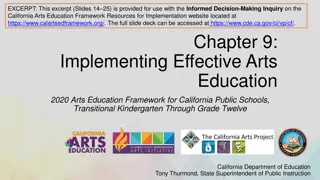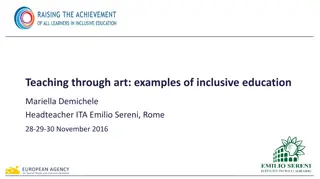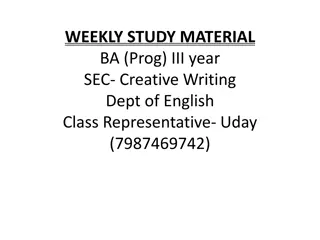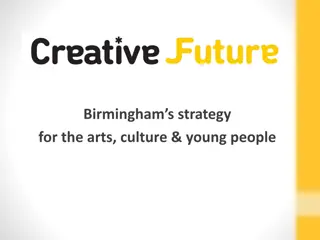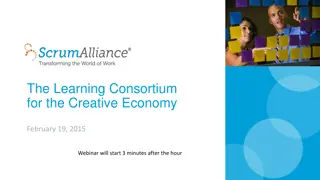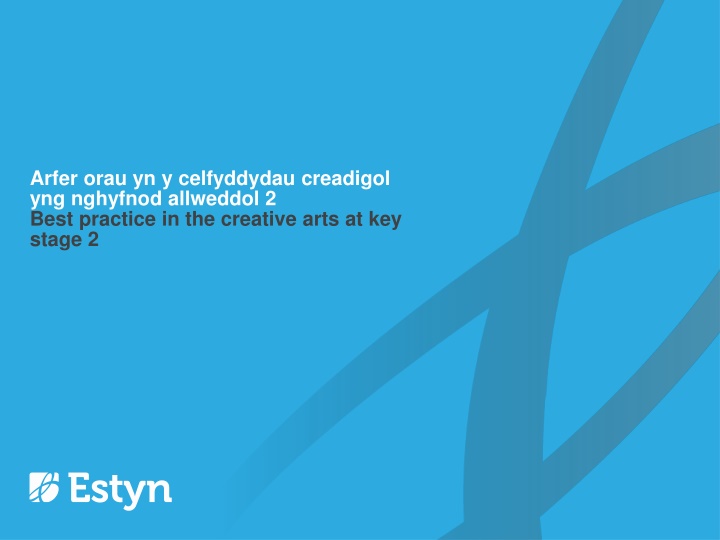
Best Practices in Creative Arts Education at Key Stage 2
Discover the main findings on best practices in creative arts education at Key Stage 2, as explored in a report by the Welsh Government. Delve into insights on standards of creative arts forms, pupil well-being, and the impact of arts on literacy skills.
Download Presentation

Please find below an Image/Link to download the presentation.
The content on the website is provided AS IS for your information and personal use only. It may not be sold, licensed, or shared on other websites without obtaining consent from the author. If you encounter any issues during the download, it is possible that the publisher has removed the file from their server.
You are allowed to download the files provided on this website for personal or commercial use, subject to the condition that they are used lawfully. All files are the property of their respective owners.
The content on the website is provided AS IS for your information and personal use only. It may not be sold, licensed, or shared on other websites without obtaining consent from the author.
E N D
Presentation Transcript
Arfer orau yn y celfyddydau creadigol yng nghyfnod allweddol 2 Best practice in the creative arts at key stage 2
Cefndir Background Caiff yr adroddiad hwn ei ysgrifennu i ymateb i gais am gyngor gan Lywodraeth Cymru yn llythyr cylch gwaith blynyddol y Gweinidog i Estyn ar gyfer 2013-2014. Mae n rhannol o ganlyniad i adroddiad yr Athro Dai Smith ar Y Celfyddydau mewn Addysg ac Ysgolion yng Nghymru (Medi 2013). Mae r adroddiad yn cynnwys astudiaethau achos o arfer orau i ysgolion eraill eu hystyried. Mae r rhain wedi u bwriadu i sbarduno trafodaethau oddi mewn i ysgolion a rhyngddynt, i hyrwyddo arfer orau mewn addysgu a dysgu ledled Cymru. This report is written in response to a request for advice from the Welsh Government in the Minister s annual remit letter to Estyn for 2013-2014. It is partly as a result of Professor Dai Smith s report Arts in Education in the Schools of Wales (September 2013). The report includes case studies of best practice for other schools to consider. These are intended to stimulate discussions within and between schools to promote best practice in teaching and learning across Wales.
Prif ganfyddiadau Main findings Yn y rhan fwyaf o r ysgolion arfer orau yr ymwelwyd nhw, mae safonau o leiaf yn dda mewn dwy neu fwy o r ffurfiau celf greadigol (celf a dylunio, dawns, drama a cherddoriaeth). Mewn lleiafrif o r ysgolion hyn, mae safonau yn y naill neu r llall o r ffurfiau celf greadigol ymhell uwchlaw r disgwyl. Fodd bynnag, anaml y mae safonau yn uchel ym mhob un o r pedwar celfyddyd greadigol mewn unrhyw ysgol unigol. In most of the best practice schools visited, standards are at least good in two or more of the creative art forms (art and design, dance, drama and music). In a minority of these schools, standards in one or other of the creative art forms are well above those expected. However, it is rare for standards to be high in all four creative arts in any one school. Pupils standards of wellbeing in nearly all of the best practice schools visited are good or excellent. Pupils and staff in these schools say that the creative arts have a very positive impact on improving pupils wellbeing. Mae safonau lles ym mron pob un o r ysgolion arfer orau yr ymwelwyd nhw yn dda neu n rhagorol. Dywed disgyblion a staff yn yr ysgolion hyn bod y celfyddydau creadigol yn cael effaith gadarnhaol iawn ar wella lles disgyblion.
Prif ganfyddiadau Main findings Mae gan lawer o ysgolion dystiolaeth dda o r effaith y mae r celfyddydau creadigol yn ei chael ar wella safonau disgyblion mewn llefaredd. Yn rhannol, y rheswm am hyn yw bod ymgysylltiad gwerthfawr r celfyddydau creadigol yn rhoi profiadau cyffrous i ddisgyblion siarad amdanynt. Yn aml, mae rcelfyddydau n darparu cyd- destun symbylol i r plant ei ddefnyddio ac i ddatblygu eu medrau llythrennedd, ond nid oes digon o dystiolaeth i ddangos bod y celfyddydau n gwella perfformiad disgyblion yn uniongyrchol mewn darllen ac ysgrifennu. Many schools have good evidence of the impact of the creative arts in improving pupils standards in oracy. This is partly because worthwhile engagement in the creative arts gives pupils exciting experiences to talk about. The arts often provide a stimulating context for pupils to use and to develop their literacy skills, but there is not enough evidence to show that the arts directly improve pupils performance in reading and writing.
Prif ganfyddiadau Main findings At ei gilydd, mae ansawdd y cwricwlwm ar gyfer y celfyddydau creadigol yn dibynnu gormod ar siawns yn hytrach nag ar gynllunio cwricwlwm sicr. Yn y rhan fwyaf o ysgolion, mae r ddarpariaeth ar gyfer y celfyddydau creadigol yn dibynnu gormod ar b un a oes athro brwdfrydig ar y staff medrau a gwybodaeth arbenigol. Er bod hyn yn aml yn sicrhau safonau uchel mewn un maes o r celfyddydau creadigol, yn aml nid yw n sicrhau safonau uchel ym mhob un ohonynt. Mae safonau disgyblion ar eu gorau pan fydd eu hathrawon yn artistiaid creadigol gwybodus a hyderus, yn ogystal ag ymarferwyr da yn yr ystafell ddosbarth. Nid oes gan lawer o athrawon nad ydynt yn arbenigwyr y wybodaeth, sgiliau na r hyder i gyflwyno r celfyddydau creadigol i r lefel uchaf, yn enwedig erbyn Blwyddyn 6. Nid oes digon o hyfforddiant a chymorth ar gael i helpu athrawon i ddatblygu eu haddysgu yn y celfyddydau creadigol. Overall, the quality of the curriculum for the creative arts relies too much on chance rather than on secure curriculum planning. In most schools, the provision for the creative arts depends too much on whether there is an enthusiastic teacher on the staff with specialist skills and knowledge. While this often secures high standards in one area of the creative arts, it often does not secure high standards in all. Pupils standards are best when their teachers are knowledgeable and confident creative artists, as well as good classroom practitioners. Many teachers who are not specialists lack the knowledge, skills and confidence to deliver the creative arts to the highest level, especially by Year 6. There is too little training and support available to help teachers develop their teaching in the creative arts.
Prif ganfyddiadau Main findings Mewn llawer o r ysgolion yr ymwelwyd nhw, mae cynllunio ar gyfer y celfyddydau creadigol yn rhoi ystyriaeth dda i r hyn y gall disgyblion ei wneud eisoes er mwyn sicrhau bod disgyblion yn datblygu eu medrau n raddol. Mewn rhai o r ysgolion yr ymwelwyd nhw, er bod cynllunio athrawon yn darparu ystod briodol o brofiadau ar draws y celfyddydau creadigol, yn gyffredinol, nid yw r profiadau nadeiladu n ddigon da ar fedrau presennol disgyblion. O ganlyniad, mae disgyblion yn cyflawni gweithgareddau diymdrech a di-her. In many of the schools visited, planning for the creative arts takes good account of what pupils can already do to ensure that pupils develop their skills progressively. In a few of the schools visited, although teachers planning generally provides an appropriate breadth of experiences across the creative arts, the experiences do not build on pupils existing skills well enough. As a result, pupils complete activities that are undemanding and lack challenge.
Prif ganfyddiadau Main findings Yn y gwersi mwyaf llwyddiannus, mae gan athrawon wybodaeth bynciol drylwyr a chynhwysfawr, y maent yn ei defnyddio i osod disgwyliadau uchel o ddisgyblion. Maent yn addysgu ag egni, rhediad a brwdfrydedd, ac yn gwybod pryd mae n briodol i ymyrryd neu herio, ac nid oes arnynt ofn caniat u amser i ddisgyblion atgyfnerthu eu dysgu. Mae athrawon yn annog disgyblion i wneud eu penderfyniadau eu hunain a mentro, fel eu bod yn dysgu o u camgymeriadau ambell waith. Lle mae addysgu n llai llwyddiannus, nid yw gweithgareddau cynlluniedig yn herio disgyblion yn ddigon da, yn enwedig y rhai mwy abl. Yn aml yn y gwersi gwannach hyn, mae athrawon yn cyfarwyddo ac yn cyfyngu gormod ar y dysgu, ac mae ar ddisgyblion ofn arbrofi rhag ofn iddynt wneud pethau n anghywir. In the most successful lessons, teachers have a thorough and comprehensive subject knowledge which they use to set high expectations of pupils. They teach with energy, pace and enthusiasm, knowing when it is appropriate to intervene or to challenge and are not afraid to allow time for pupils to consolidate their learning. Teachers encourage pupils to make their own decisions and to take risks, so that sometimes they learn from their mistakes. Where teaching is less successful, planned activities do not challenge pupils well enough, especially the more able. Often in these weaker lessons, teachers direct and constrain the learning too much and pupils are afraid to experiment for fear of getting things wrong.
Prif ganfyddiadau Main findings In the best practice schools visited, senior leaders share a passion and vision for the creative arts. They believe that the creative arts inspire, stimulate and motivate pupils to think imaginatively, to persevere and to respond positively to challenges. In these schools, leaders find imaginative ways to maintain a high profile for the creative arts, despite the limitations of the national curriculum and pressures on financial resources. In nearly all of the schools visited, leaders identify that it is possible to teach the creative arts well within the primary curriculum. However, in around half of the schools surveyed, leaders have recently reduced the time assigned to the creative arts. In many cases, this is because they believe that devoting resources to the arts detracts from improving measureable outcomes in literacy and numeracy. Yn yr ysgolion arfer orau yr ymwelwyd nhw, mae uwch arweinwyr yn rhannu brwdfrydedd a gweledigaeth ar gyfer y celfyddydau creadigol. Credant fod y celfyddydau creadigol yn ysbrydoli, symbylu ac ysgogi disgyblion i feddwl yn greadigol, dyfalbarhau ac ymateb yn gadarnhaol i heriau. Yn yr ysgolion hyn, daw arweinwyr o hyd i ffyrdd dychmygus i gynnal proffil uchel ar gyfer y celfyddydau creadigol, er gwaethaf cyfyngiadau r cwricwlwm cenedlaethol a phwysau ar adnoddau ariannol. Ym mron pob un o r ysgolion yr ymwelwyd nhw, mae arweinwyr yn nodi ei bod yn bosibl addysgu r celfyddydau creadigol yn dda o fewn y cwricwlwm cynradd. Fodd bynnag, mewn tua hanner yr ysgolion a gymerodd ran yn yr arolwg, mae arweinwyr wedi lleihau r amser a roddir i r celfyddydau creadigol yn ddiweddar. Mewn llawer o achosion, y rheswm am hyn yw eu bod yn credu bod neilltuo adnoddau i r celfyddydau yn tynnu oddi wrth wella deilliannau mesuradwy mewn llythrennedd a rhifedd.
Prif ganfyddiadau Main findings In many of the schools, subject leaders provide comprehensive plans to support colleagues to deliver lessons in the creative arts. These schemes of work often pay good attention to a breadth of engaging creative experiences, but in the weaker examples the schemes pay too little attention to the progressive development of pupils skills. In particular, many schemes of work do not refer to the materials which exemplify the expected standards in the creative arts. Subject leaders for the creative arts often monitor the provision within their subjects carefully and produce annual reports for governors and senior leaders. While the monitoring process ensures reporting and evaluation of pupil engagement and participation, too often it does not evaluate the standards that pupils achieve or say how they could be improved. Mewn llawer o r ysgolion, mae arweinwyr pwnc yn darparu cynlluniau cynhwysfawr i gynorthwyo cydweithwyr i gyflwyno gwersi yn y celfyddydau creadigol. Yn aml, mae r cynlluniau gwaith hyn yn rhoi sylw da i ystod o brofiadau creadigol atyniadol, ond yn yr enghreifftiau gwannach, nid yw rcynlluniau n rhoi digon o sylw i ddatblygu medrau disgyblion yn raddol. Yn benodol, nid yw llawer o gynlluniau gwaith yn cyfeirio at y deunyddiau sy nenghreifftio r safonau disgwyliedig yn y celfyddydau creadigol. Yn aml, mae arweinwyr pwnc ar gyfer y celfyddydau creadigol yn monitro r ddarpariaeth yn eu pynciau n ofalus ac yn llunio adroddiadau blynyddol i lywodraethwyr ac uwch arweinwyr. Er bod y broses fonitro n sicrhau y caiff ymgysylltiad a chyfranogiad disgyblion eu harfarnu a u hadrodd arnynt, yn rhy aml, nid yw n arfarnu r safonau y mae disgyblion yn eu cyflawni nac yn dweud sut y gellid eu gwella.
Prif ganfyddiadau Main findings Ychydig iawn o r ysgolion yr ymwelwyd nhw sy n rhannu arfer dda yn y celfyddydau creadigol ac yn cydgyfrannu adnoddau. Yn aml, mae r ysgolion hyn yn darparu gwersi enghreifftiol i eraill eu harsylwi, ac maent yn cynnal neu n cyflwyno sesiynau hyfforddi i gydweithwyr o u hysgolion eu hunain ac ysgolion eraill. Fodd bynnag, mae gormod o ysgolion yn gweithio ar eu pennau eu hunain ac nid ydynt yn elwa ar gydweithio ag ysgolion eraill. Mae bron pob un o r ysgolion yr ymwelwyd nhw neu a gymerodd ran yn yr arolwg yn cynnig gwersi cerddoriaeth offerynnol, er mewn chwarter o r ysgolion, dim ond ychydig iawn o ddisgyblion sy n manteisio ar y gwersi hyn. Nid yw tua hanner yr ysgolion yr ymwelwyd nhw yn codi t l ar ddisgyblion am wersi offerynnol, ond mewn ychydig iawn o ysgolion, mae disgwyl i bob disgybl dalu r gost lawn am wersi offerynnol. Yn yr ysgolion hyn, nid yw disgyblion o deuluoedd tlotach yn dewis canu offeryn cerdd oherwydd bod y gost yn afresymol. A very few of the schools visited share best practice in the creative arts and pool resources. Often these schools provide model lessons for others to observe, and they host or deliver training sessions for colleagues from their own and other schools. However, too many schools work in isolation and do not benefit from working with other schools. Nearly all of the schools visited or surveyed offer instrumental music lessons, although in a quarter of the schools only a very few pupils take up the lessons. Around half of the schools visited do not charge pupils for instrumental lessons, but in a very few schools all pupils are expected to pay the full cost of instrumental tuition. In these schools pupils from poorer families do not chose to learn to play a musical instrument, because the cost is prohibitive.
Prif ganfyddiadau Main findings Mae ymweliadau safleoedd treftadaeth a theatrau yn cael effaith sylweddol iawn ar ddysgu disgyblion. Yn yr arfer fwyaf effeithiol, mae athrawon yn cynllunio ac yn paratoi n ofalus ar gyfer yr ymweliadau, er mwyn i r disgyblion fanteisio i r eithaf ar y profiad, ac maent yn mynd ar drywydd dysgu r disgyblion yn gyflym wedi iddynt ddychwelyd i r ysgol. Mae bron pob un o r ysgolion a gymerodd ran yn yr arolwg yn mynd disgyblion ar deithiau ac ymweliadau, neu n croesawu ymwelwyr i r ysgol, yn ymwneud r celfyddydau creadigol. Yn y rhan fwyaf o r ysgolion arfer orau, mae arweinwyr yn sicrhau bod pob disgybl, gan gynnwys y rhai o deuluoedd tlotach, yn cymryd rhan mewn teithiau ac ymweliadau trwy leihau neu hepgor costau. Fodd bynnag, mae ymatebion gan ysgolion a gymerodd ran yn yr arolwg yn dangos nad yw hyn yn wir bob tro. Visits to heritage sites and theatres have a very significant impact on pupils learning. In the most effective practice, teachers plan and prepare carefully for the visits so the pupils get the most from the experience and they follow up pupils learning quickly once back at school. Nearly all schools surveyed take pupils on trips and visits, or receive visitors in school, related to the creative arts. In most of the best practice schools, leaders ensure that all pupils, including those from poorer families, take part in trips and visits by reducing or waiving costs. However, responses from schools participating in the survey show that this is not always the case.
Argymhellion Recommendations Er mwyn gwella darpariaeth a chodi safonau yn y celfyddydau creadigol: In order to improve provision and to raise standards in the creative arts: Dylai ysgolion: Gynllunio dilyniant o gyfleoedd dysgu i ddisgyblion gael profiad o ehangder y celfyddydau creadigol a datblygu eu medrau creadigol wrth iddynt symud trwy r ysgol Cynorthwyo athrawon i ddatblygu r medrau, gwybodaeth a hyder i addysgu r celfyddydau creadigol yn dda Monitro cyflawniadau disgyblion yn y celfyddydau creadigol Cydweithio n agosach ag ysgolion eraill i rannu arfer orau ac adnoddau yn y celfyddydau creadigol Schools should: Plan a sequence of learning opportunities for pupils to experience the breadth of the creative arts and develop their creative skills as they move through school Support teachers to develop the skills, knowledge and confidence to teach the creative arts well Monitor pupils achievements in the creative arts Work more closely with other schools to share best practice and resources in the creative arts
Argymhellion Recommendations Dylai awdurdodau lleol a r consortia rhanbarthol: Local authorities and the regional consortia should: Gynnig cyfleoedd i athrawon ddatblygu eu medrau a hyder mewn addysgu un neu fwy o bynciau r celfyddydau creadigol Offer opportunities for teachers to develop their skills and confidence in teaching one or more creative arts subjects Darparu hyfforddiant i ysgolion i w helpu i nodi, datblygu a rhannu arfer orau mewn addysgu ac asesu yn y celfyddydau creadigol Provide training for schools to help them to identify, develop and share best practice in teaching and assessment in the creative arts
Argymhellion Recommendations Dylai Llywodraeth Cymru: The Welsh Government should: Barhau i gynorthwyo ysgolion i wneud defnydd o gyllid pwrpasol i alluogi disgyblion o deuluoedd tlotach i ddysgu i chwarae offerynnau cerdd a chymryd rhan lawn yn y celfyddydau creadigol Continue to support school to make use of dedicated funding to enable pupils from poorer families to learn to play musical instruments and to take a full part in the creative arts Cyhoeddi deunyddiau sy n rhoi enghreifftiau o r safonau disgwyliedig yn y celfyddydau creadigol Publicise materials that exemplify the expected standards in the creative arts
Cwestiynau i ddarparwyr Questions for providers A oes gan ein holl athrawon y medrau, gwybodaeth a r hyder i addysgu r celfyddydau creadigol yn ddigon da? Os nac oes, sut gallwn ni wella r sefyllfa? Do all of our teachers have the skills, knowledge and confidence to teach the creative arts well enough? If not, how can we improve the situation? A ydym yn gwybod pa mor dda y mae r safonau y mae ein disgyblion yn eu cyflawni yn y celfyddydau creadigol yn cymharu disgwyliadau cenedlaethol? Ym mha feysydd o r celfyddydau creadigol y mae ein disgyblion yn rhagori, a lle nad ydynt yn cyflawni cystal? A ydym yn gwybod pam y mae gwahaniaeth? Sut gallwn ni wella deilliannau i ddisgyblion? Do we know how well the standards our pupils achieve in the creative arts compare to national expectations? In which areas of the creative arts do our pupils excel, and where do they achieve less well? Do we know why there is a difference? How can we improve pupils outcomes?
Cwestiynau i ddarparwyr Questions for providers Ystyriwch ddarpariaeth ein hysgol ar gyfer y celfyddydau creadigol. A yw r profiadau rydym yn eu cynnig i n disgyblion yn darparu ehangder digonol? A ydynt yn helpu disgyblion i ddatblygu eu medrau creadigol yn raddol? Consider our school s provision for the creative arts. Do the experiences we offer our pupils provide sufficient breadth? Do they help pupils to develop their creative skills progressively? Do we share best practice and resources in the creative arts with other schools in our cluster and authority? A ydym yn rhannu arfer orau ac adnoddau yn y celfyddydau creadigol ag ysgolion eraill yn ein clwstwr a r awdurdod?
Cwestiynau i ddarparwyr Questions for providers A ydym yn darparu cyfle cyfartal i n holl ddisgyblion gymryd rhan yn yr ystod lawn o weithgareddau celfyddydau creadigol? Pa gyfran o n disgyblion o gefndiroedd difreintiedig sy n dysgu i chwarae offerynnau cerdd, neu n cymryd rhan mewn gweithgareddau celf, dawns a drama y tu allan i r ysgol? A oes angen i ni sicrhau cyfle cyfartal i bawb? Do we provide equal opportunities for all of our pupils to take part in the full range of creative arts activities? What proportion of our pupils from deprived backgrounds learn musical instruments, or take part in art, dance and drama activities outside of school? Do we need to level the playing field ?
Cwestiynau i ddarparwyr Questions for providers Ym Mawrth 2015, lansiodd Llywodraeth Cymru Gynllun y Celfyddydau a Dysgu Creadigol i Gymru. Lluniwyd y cynllun hwn i greu newid sylweddol yn ystod ac ansawdd y cyfleoedd a roddir i blant a phobl ifanc yng Nghymru i gael dysgu am eu diwylliant a r celfyddydau, a chymryd rhan ynddynt . Caiff hyn ei gyflawni trwy weithio mewn partneriaeth Chyngor Celfyddydau Cymru. Mae rhagor o wybodaeth am Gynllun y Celfyddydau a Dysgu Creadigol i w gweld ar wefan Llywodraeth Cymru. In March 2015 the Welsh Government launched the Arts and Creative Learning Plan for Wales. This plan is designed to bring about a step change in the range and quality of opportunities that children and young people in Wales are given to engage with and learn about the arts and their culture . It will be achieved through partnership work with the Arts Council of Wales. Further details of the Arts and Creative Learning Plan can be found on the Welsh government website. Would it benefit our school to be involved in this national priority? A fyddai o fudd i n hysgol gymryd rhan yn y flaenoriaeth genedlaethol hon?
Dolen we ir adroddiad llawn: Web-link to full report: www. www.
Cwestiynau... Questions


